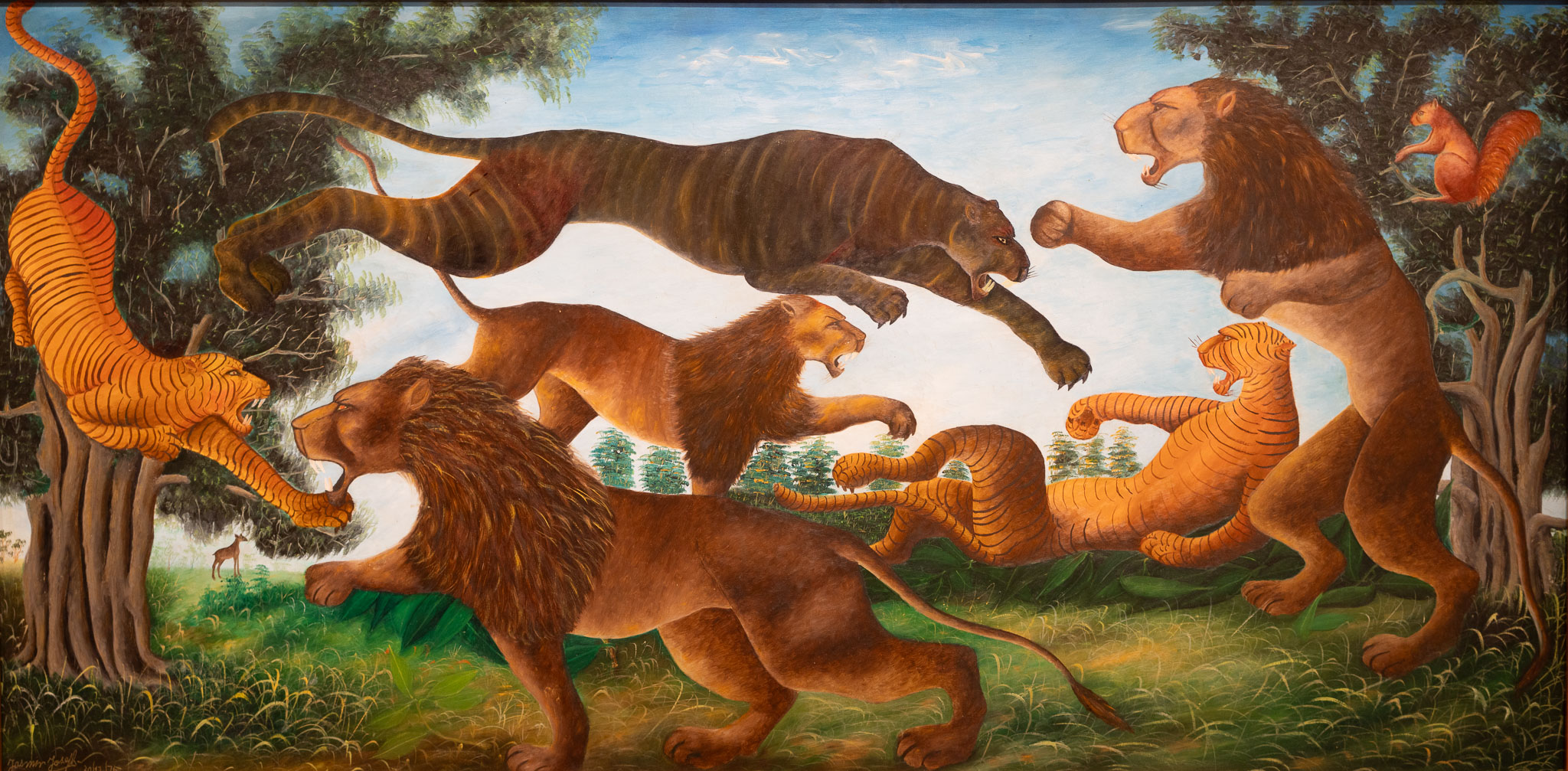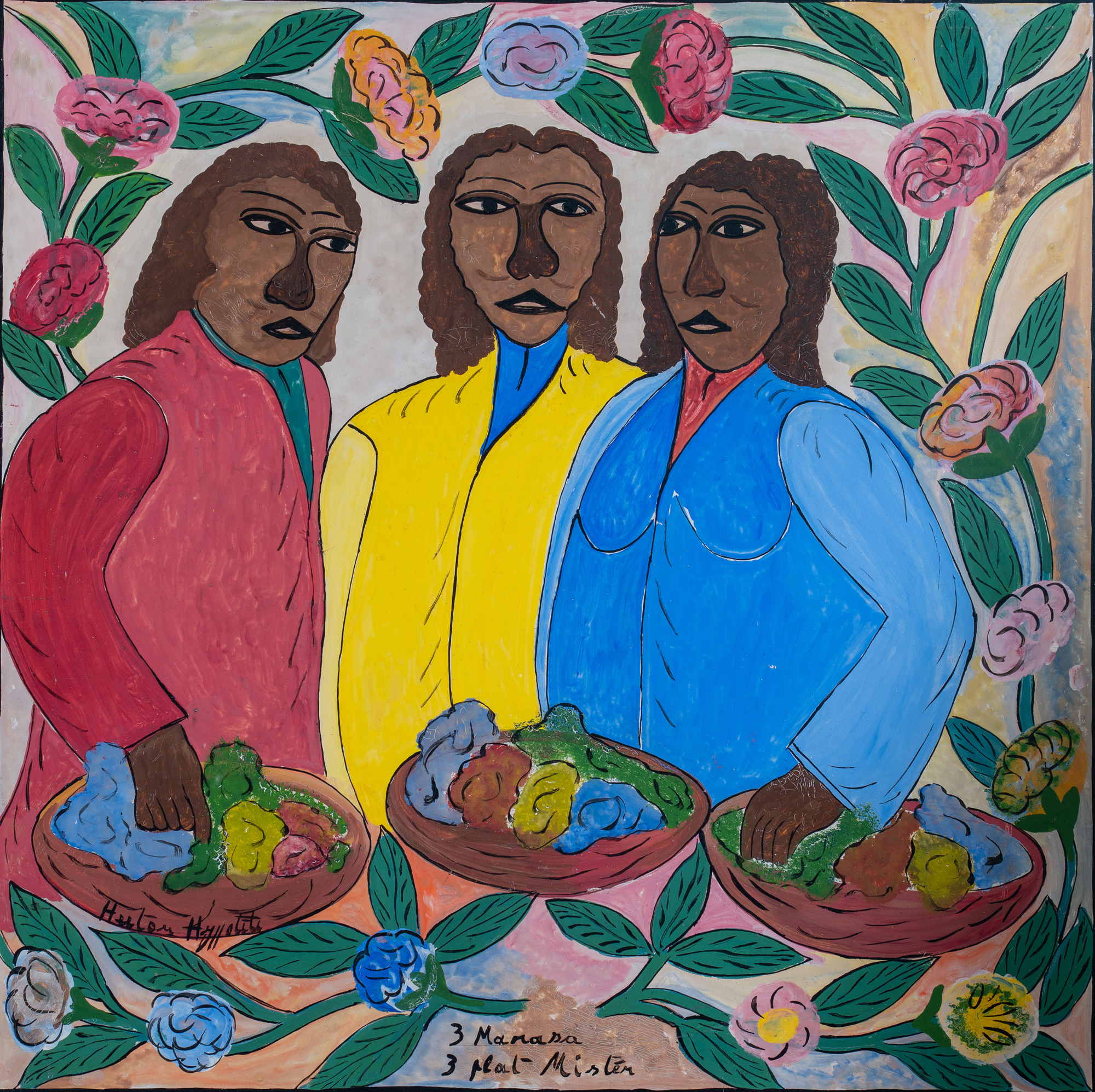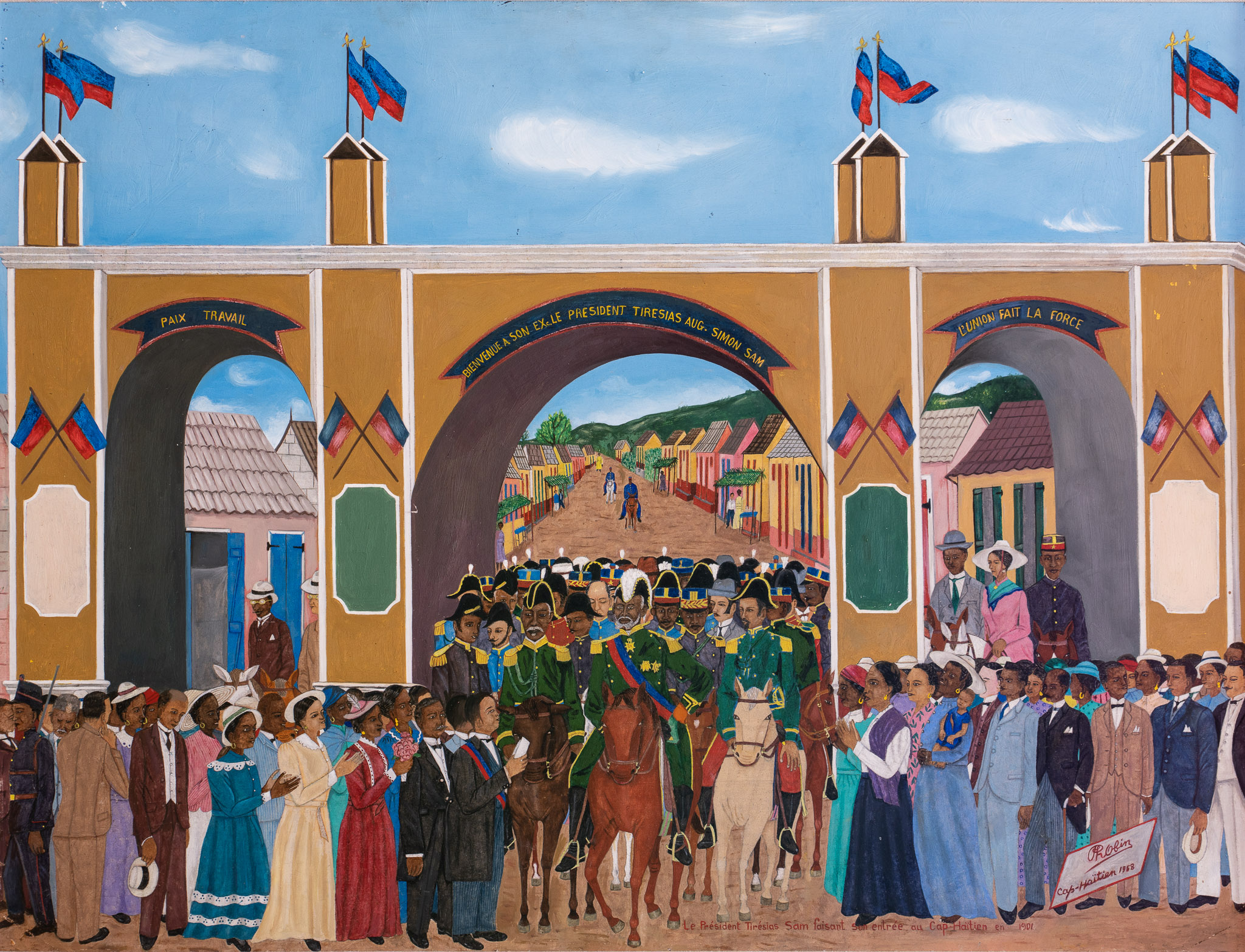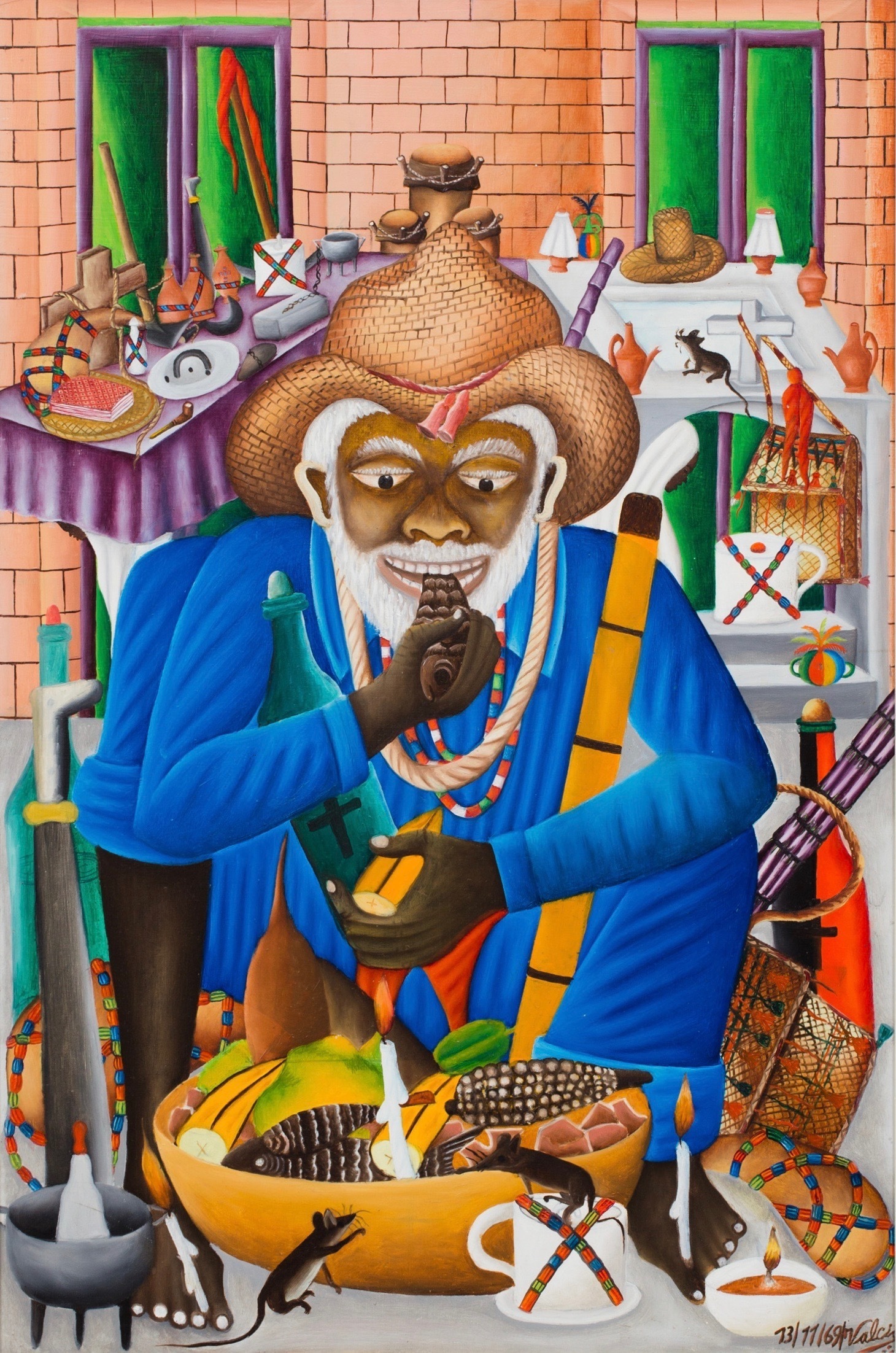At the National Gallery, loving Haitian art is a patriotic act
October 23, 2024 at 6:00 a.m.
Review by Philip Kennicott, Art and architecture critic, Washington Post

At a National Gallery of Art reception in September, museum director Kaywin Feldman thanked the donors of 15 modern and contemporary works by Haitian artists for their recent “patriotic gift to the nation’s museum.” She placed a slight but unmistakable emphasis on the word “patriotic,” which produced a palpable moment of electricity in the crowd. Any gift to the National Gallery is theoretically an act of patriotism. But this gift, by donors who have visited and loved Haiti for decades, came at a moment of profound disgrace in the United States’ relationship to a neighbor with whom it shares revolutionary origins, an African diaspora and centuries of inextricably intertwined history.
Weeks earlier, the Republican nominee for president, Donald Trump, had repeated a ludicrous assertion that Haitian immigrants in Ohio were eating cats and dogs, and his running mate, Sen. JD Vance of Ohio, doubled down on the claim, endangering his own constituents in Springfield. It was yet one more low point in the ugly, obsessive and deeply gothic history of the United States’ abuse of Haiti, Haitians and Haitian Americans.
“It is stunning to think that the spotlight of this gallery would shine down on this art,” said John Fox Sullivan, who with his wife, Beverly Sullivan, collected many of the works acquired by the gallery and now on view in an exhibit called “Spirit & Strength: Modern Art From Haiti.”
That’s an understatement. Haitian art has been championed and ignored, collected and derided, centered and marginalized for decades, circulating at the edges of the mainstream art world. It exists as modern art in some contexts, outsider or folk art in others, and even the least condescending descriptors applied to it are misleading: naive, surreal, joyous, primitive, exotic, disturbing, authentic.
But by accessioning key works by some of the country’s most renowned painters, including Hector Hyppolite, Philomé Obin, Rigaud Benoit and Wilson Bigaud, the National Gallery has effectively canonized it. This follows the appearance, at the main pavilion exhibition at this year’s Venice Biennale, of works by Obin and his brother Sénèque Obin, a surprising yet delightful swerve by the world’s premier art festival away from its usual focus on supposedly more complex modernist idioms.
It is rare to see that process, the migration from margins to artistic metropole, happen so decisively. The arrival of this art, collected by dedicated private enthusiasts, at the National Gallery sends a twofold message: The people who made it had a unique and compelling vision worthy of full inclusion in the permanent collection, and the history of the United States can’t be understood without engaging with the country and culture they depicted in their work.

The exhibition featuring works from the collections of John and Beverly Sullivan and Kay and Roderick Heller elaborates on an essential connection between the two countries. In the 20th century, African Americans and Black artists turned to Haiti, inspired by its history as the world’s first Black republic and seeking connection and inspiration as they fought for their own equality and dignity. Leading figures in African American history were deeply engaged with Haiti, including Frederick Douglass, who served as ambassador to the Caribbean nation, and W.E.B. Du Bois, who helped lead resistance to the brutal 1915-1934 U.S. occupation of Haiti.
African American artists, musicians, choreographers and writers had a vital but often fraught exchange, and Black Americans weren’t immune to condescension to Haiti, especially if their own cultural allegiances were primarily modernist, urban or European. The exhibition includes a 1938 street scene by Aaron Douglas and a 1981 watercolor called “The Green Door,” by Lois Mailou Jones, both of which suggest the artists were more engaged with light, color and place than with the people of Haiti. Compare those works with Rigaud Benoit’s masterful 1965 “Marketplace” in which dozens of figures are individuated not by their relationship to the land, which is a blank sea of sandy brown, but by their relationships to one another, to work, commerce and the necessities of life.
Douglas and Jones were at least looking and observing with sensitivity. Others sought to take a more direct hand in directing the course of Haitian art. And then there was André Breton, the surrealist French poet often credited with discovering the painter Hyppolite, who is represented in the Gallery’s acquisition by an intriguing landscape, “Houses by the Bay,” and “3 Marassa,” which depicts twins with a child, a powerful, tripartite symbol within Vodou, the Haitian religion.
Breton’s enthusiasm for Hyppolite established the artist as a founding figure within the Haitian art movement of the mid-20th century. It also foregrounded Vodou, a rich source of visual imagery, and connected both Haitian religion and Haitian art to European fantasies of the exotic and the irrational and unconscious mind.
“I don’t think there is any country in the world that has more stuff projected on to it than Haiti,” says Laurent Dubois, an author and professor of history at the University of Virginia, whose work has focused on Haiti. Dubois, in an interview before the opening of the exhibition, said those projections include the fears of White enslavers in the United States after Haitian independence in 1804, the “discovery” of Haiti and Vodou, and the mythologizing of the religion during and after the U.S. occupation. It also includes the lingering fears of Haitian poverty — the direct result of colonial oppression — and the AIDS crisis of the 1980s, as well as romanticized but false views of the island formed during booms of tourism in the 1940s and ’50s and again in the 1970s (Bill and Hillary Clinton spent their honeymoon there in 1975).
For artists, that could mean making work tailored to the desires of local elites or catering to the tastes of outside visitors who wanted souvenirs. That isn’t exclusive to Haiti — Canaletto and Francesco Guardi were doing the same thing in 18th-century Venice. But even when projections and expectations aren’t explicitly negative, they are limiting. They confine and channel the energy of creative people.
“Haitian artists and writers,” says Dubois, were “navigating an exceedingly complicated matrix of expectations.”

That has also been a barrier to the inclusion of Haitian art in so-called “high art” institutions. To some visitors, the brilliantly colored work on view at the National Gallery, the street scenes and animal pictures, will have to be filtered through their own expectations. Is this tourist art? An imitation of “naive” European artists, like Henri Rousseau? Untutored or unpolished art?
Dubois, who has spent a career looking at this work deeply, argues that there is a range of complexity and depth in Haitian art, as there is in any nation’s art movements. Landscapes can be both descriptive and symbolic; market scenes capture not just the minutiae of life but also a social milieu in which women are a dominant force.
One extraordinary work in the new exhibition, “The Fight” by Jasmin Joseph, depicts a circular melee of lions and wildcats engaged in useless combat, with the animals every bit as dynamic and lifelike as in a painting by George Stubbs or Rosa Bonheur. But the curators of the exhibition, organized by Kanitra Fletcher, point out that the painting’s date, 1975, makes it a likely allegory of the brutality of the regime of Jean-Claude “Baby Doc” Duvalier, which saw tens of thousands of Haitians seek safety in the United States.

Art is never just art, and even with the expectations and projections placed on Haitian artists, they also enjoyed a freedom we can now read in a new context.
“They maybe didn’t have that much control over a lot of things in their lives, but they did have control over the vision that they put on the canvas,” Dubois says. “They’re presenting a way of seeing the world, and it’s important to have this.”
That may be the most important challenge of the work, to see its particularity, to comprehend and savor the way in which it depicts people who are different but the same. After the appalling slanders leveled at Haitian migrants in Ohio, the state’s governor, Mike DeWine, published an editorial in the New York Times defending the new residents as hardworking, decent people, framing their presence in the familiar context of people fleeing a violent and failed state in search of a better future: “We know that the Haitian people want the same things we all want — a good job, the chance to get a quality education and the ability to raise a family in a safe and secure environment.”
All of that is true. They are just like us. Now, visitors to the National Gallery will have a chance to contemplate an equal truth: the difference, particularity and vision of people who are also different from us, which is a fundamentally patriotic act in a pluralistic democracy.
Spirit & Strength: Modern Art From Haiti is on view at the National Gallery of Art through March 9.
Philip Kennicott, Art and architecture critic
Philip Kennicott is the Pulitzer Prize-winning art and architecture critic of The Washington Post. He has been on staff at The Post since 1999, first as classical music critic, then as culture critic. In 2011, he combined art and architecture into a beat focused on visual culture and public space.
Washington Post, October 23rd, 2024